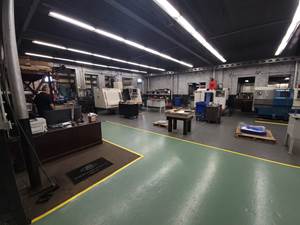Faster Production of Inside Threads
Modern tools, control and software create a range of options for producing inside threads efficiently.
Share





There are different ways to produce internal threads. In conventional tapping, threads are cut into a predrilled hole using a screw tap, either manually or by a machine.
Cold-forming taps, by contrast, are used for the chipless creation of threads. The thread is not created by cutting, but by cold forming, with the material pressed into the required profile.
With the development of CNC machine tools, thread milling was introduced as an additional possibility. Here, the thread is milled into the hole using specific circular and feed motions of the tool. Each of these three methods is suited to different applications.
The “Classic” Method: Tapping
In conventional tapping, material is removed in a continuous cut. Tapping comes up against its limits in materials with hardness greater than 60 HRC, as well as in deep threads, where problems arise related to dimensional accuracy and tool breakage due to chip-removal difficulty.
Chipless: Cold-Form Tapping
Cold-form tapping is used for materials with a strength of less than 1200 N/mm2 and a stretch-at-break of more than 8 percent. Thanks to cold-forming, this chipless process achieves threads with higher static and dynamic strength in combination with very good surface quality.
However, the disadvantages of cold-form tapping include the high torques compared to conventional tapping, as well as the need for high-quality lubricants.
Productive and Precise: Thread Milling
Thread milling is suitable for almost all materials and offers the greatest flexibility and productivity. Thread flanks are machined cleanly and there is no axial miscut. For hard-to-machine materials, thread milling tends to be the best method. One underappreciated advantage is the fact that when the tool breaks, it can be removed easily. The restrictions on thread milling relate to the thread depth, which can generally be no more than 3 times the thread diameter.
Whatever threading method is used, one thing is certain: With the thread cycles in today’s advanced CNC software modules, programming is quick and easy.
Cycles for the Production of Inside Threads
The actual programming requirements of inside threads are complex, because a number of math values have to be taken into consideration. Advanced CNC thread cycles can take care of this complexity in an efficient manner. These cycles ask input factors including the required tool, thread depth and cutting speed, as well as procedure-specific parameters.
Those procedure-specific inputs take into account the individual characteristics of the particular tapping operation—such as, for example, whether the conventional tapping thread is to be produced in a single cut or via chipbreaking. If yes, the reversal movement and change in direction of rotation for chip breaking can be automatically programmed the software.
Linking of Work Steps
Separate work steps typically also are needed for the production of inside threads. For example, the hole is centered and pre-drilled before the inside thread is created. If the workpiece contains several identical inside threads, then these work steps must be repeated for each position. To reduce the programming work involved, sub-programs can be created that are called up for the various positions.
In fact, with the proper CNC software, programming of these steps can be carried out even more efficiently. All the work steps are programmed just once, then linked via a position pattern. The programming for centering, drilling and tapping is created one time, applying to all positions of the pattern. Configurable cycles for lines, hole circles, grids, frames and special positions are available as these position patterns.
About the author: Randy Pearson is the Siemens sales support manager for U.S. dealers and OEMs. A specialist in CNC training, he participates in various seminars and classes Siemens conducts at schools and shops, as well at Siemens training facilities around the country.
Related Content
5 Reasons Why You Should Know How to Write Custom Macros
Custom macros enhance what can be done in G-code programs, giving users the ability to code operations that were previously not possible.
Read MoreTips for Designing CNC Programs That Help Operators
The way a G-code program is formatted directly affects the productivity of the CNC people who use them. Design CNC programs that make CNC setup people and operators’ jobs easier.
Read MoreFrom Tradition to Transformation: Century-Old Manual Machine Shop Adds CNCs
After 122 years of working with manual mills and lathes, this fifth-generation shop acquired assets of a local CNC machining business and hired the owner. Here’s how it’s going a year later.
Read More2 Secondary Coordinate Systems You Should Know
Coordinate systems tell a CNC machine where to position the cutting tool during the program’s execution for any purpose that requires the cutting tool to move.
Read MoreRead Next
AMRs Are Moving Into Manufacturing: 4 Considerations for Implementation
AMRs can provide a flexible, easy-to-use automation platform so long as manufacturers choose a suitable task and prepare their facilities.
Read MoreMachine Shop MBA
Making Chips and Modern Machine Shop are teaming up for a new podcast series called Machine Shop MBA—designed to help manufacturers measure their success against the industry’s best. Through the lens of the Top Shops benchmarking program, the series explores the KPIs that set high-performing shops apart, from machine utilization and first-pass yield to employee engagement and revenue per employee.
Read More




















